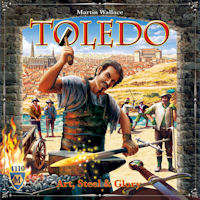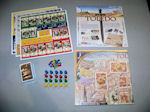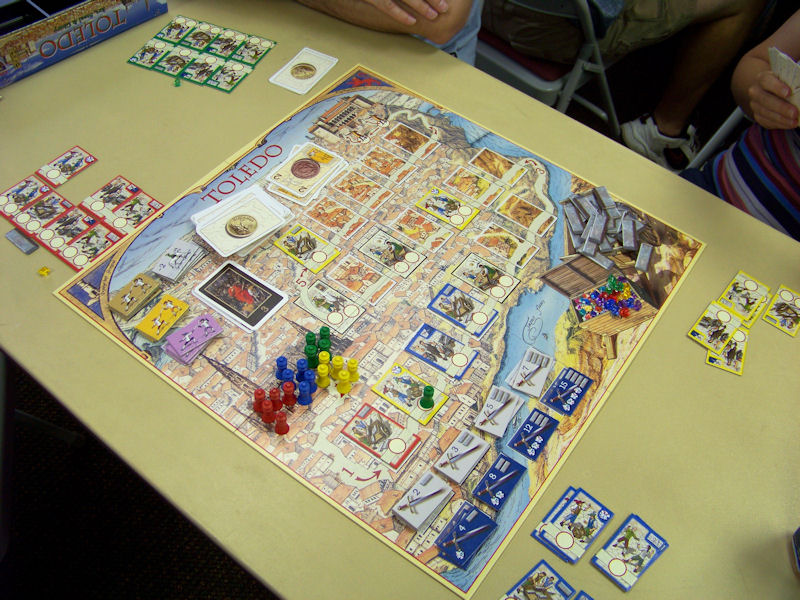
|
Toledo A game by Martin Wallace Published by Kosmos Games and distributed in the US by Mayfair Games, Inc. Players: 2-4 Time: 60 minutes Reviewed by Susan Rozmiarek |

|
Toledo is a game by Martin Wallace and published by Mayfair Games that has players as Spaniards in the city of Toledo, gathering the necessary resources to craft fine swords to present to Emperor of the Spanish Empire.
Components:
- Wooden pawns, 5 in each of the 4 player colors
- 32 business tiles
- 90 cards
- 16 skill tiles
- 19 sword tiles
- 23 steel counters
- 20 colorful plastic gems
- Game board
- Rules - four pages in color illustrated with examples. They are clear and easy to understand.
Game play:
The map depicts the city of Toledo with a linear trail of business locations starting in the Cathedral and winding its way up to the Alcazar in the top right corner. The businesses include a steel merchant, a gem merchant, a swordsmith, and a fencing master. Each player starts the game with two of each of theses businesses to place, each with either one or two spots for a pawn. In addition to these types, there are a few fixed on the board. These include an artist selling paintings worth victory points and a tavern where you can discard a card to draw three new ones.
The game is a sort of race and resource collection game. Players are trying to get gems and steel from those merchants and then take them to a swordsmith to craft a sword to present to the Emperor. When he does this, the player discards the resources and claims the appropriate sword tile. The swords differ in value depending on how many resources are necessary to make them and there are a limited number to make. There are only a very few of the higher valued swords and you feel under pressure to claim them first. To present a sword, the player must move a pawn into Alcazar.
On a player's turn, he chooses one of the following actions:
- Draw two movement cards
- Place one of his businesses on the board
- Play cards to move one or more pawns
- Send one of his pawns back to the Cathedral.
Planning out a movement turn is my favorite part of the game. To move, you play a numbered movement card and move a pawn that many spaces. You can play multiple cards of the same number to keep moving the same pawn or move another. Anytime a pawn lands on a business it can transact there as long as there is an open spot. Otherwise, you may play another card to keep moving or challenge the occupying pawn to a duel. (Duels are explained below). So, if you manage to collect cards of the same number, you might be able to pull off a killer move in which you do multiple transactions.
In most of my games, placing businesses dominated the early turns until all the spaces were filled. This is because doing transactions at your own business is free. It costs a movement card to use another player's business. The further the business is along the path, the higher the cost to do business there, still paid with a single movement card but with a higher number on it. There are not enough spaces for everyone's businesses so you want to put out as many of yours as you can. It can also be a good strategy to place them the same distance apart so you can hit a string of your own businesses on a single turn with the right cards
If you land on a business blocked by a player, you can challenge him to a duel. To duel, players randomly flip movement cards from the deck. Besides a number, movement cards also depict two swordsman dueling - a defender and an attacker, with one being highlighted as the winner of the duel. These also match by color, one of three different training tiles that you can buy from a fencing master. To win the duel, you must win two out of three matches either by having the training tile depicted or, if neither player has the training tile, by being the winner shown - attacker or defender. The loser has to place his pawn back in the Cathedral. Sometimes losing is actually a good thing if you need to re-visit some of the early businesses.
Challenging a player to a duel is probably my least favorite part of the game. I'm sure that there is a good reason for this mechanism. Perhaps it is to prevent somebody from blocking a key business for too long. However, it felt a little tacked-on to me and too lucky. Obviously, you can mitigate the luck by getting training, but with the pressure on to get resources to claim swords, I usually didn't want to bother. In fact, in most of my games, there were only a few fencing master businesses placed on the board. However, there is one other training tile you can get from the fencing master and it seems to be much more valuable. This is a tile that allows you break the movement rule and play a card that is a different number from the ones you are playing that turn. The downside is that it is worth a minus two points if you have it at the end of the game. There is a way to get rid of it. You can only hold three different training tiles at a time so it you collect the other three you can discard the movement one.
Once a player has three pawns in Alcazar, each other player gets one more turn and the game is over. Points are totaled and the player with the most is the winner. Swords that have been presented earn their full value and swords that are still en route earn half their value. Gems earn one point for every two and paintings earn victory points as shown on the card.
Comments:
This is not your typical Martin Wallace game.
If you go into your first game of Toledo expecting a heavy game of conflict and/or tight economics, you will be sorely disappointed.
It actually feels to me like some of the older, German family games that were often some sort of race game with a mix of luck,
tactics and a little bit of "take that."
While I wouldn't call it a spectacular game, it is a fairly solid design and one that would be good
to pull out with casual gamers and family.
| Other Web information: |
This page viewed
E-mail Ed Rozmiarek with questions or problems concerning this page.
Copyright © 2008, Ed & Susan Rozmiarek. No portion of this website may be reproduced or copied without the consent of Ed or Susan Rozmiarek.




